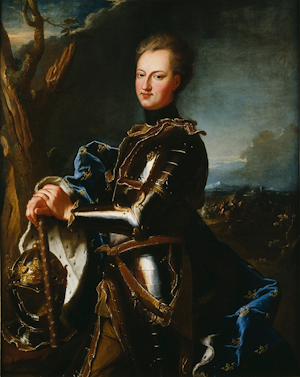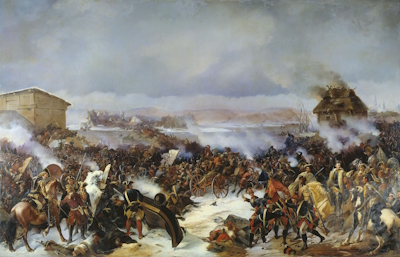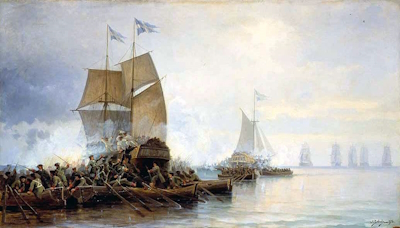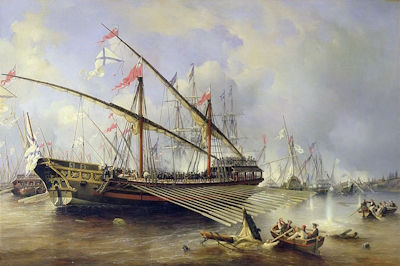Prelude to war
 At the time the war broke out, Sweden was one of the most powerful countries in Europe. The French writer Voltaire (1694-1778) called it the ‘Famous War of the North.’ From 1560 and 1700, the Swedes had built up a Baltic Empire under great leaders such as Gustavus Adolphus with their small but professional army, including occupying the provinces of Karelia, Ingria, Estonia, and Livonia in the east and Western Pomerania, Wismar, the Duchy of Bremen, and Verden, as well as parts of Denmark and Norway in the west. By the end of 17th century Sweden had an empire which nearly circled the entire Baltic Sea. Charles XII took over throne of Sweden as absolute monarch at the age of fifteen and his neighbours saw weakness and their chance to reclaim some of the lost land. The west-looking Peter I of Russia wanted a port in the Baltic, previously taken over by the Swedes in Treaty of Stolbovo (1617). The cousin of Charles XII, Frederick IV of Denmark-Norway, had lost land in southern Sweden, which had given the Swedish control of the Öresund Strait. The Danes wanted this territory back. Augustus II, Elector of Saxony and King of Poland-Lithuania, had set his eyes on Livonia, whose mainly German nobles offered to make him an hereditary king if he liberated them from the Swedes. These three countries form a secret alliance against Charles XII.
At the time the war broke out, Sweden was one of the most powerful countries in Europe. The French writer Voltaire (1694-1778) called it the ‘Famous War of the North.’ From 1560 and 1700, the Swedes had built up a Baltic Empire under great leaders such as Gustavus Adolphus with their small but professional army, including occupying the provinces of Karelia, Ingria, Estonia, and Livonia in the east and Western Pomerania, Wismar, the Duchy of Bremen, and Verden, as well as parts of Denmark and Norway in the west. By the end of 17th century Sweden had an empire which nearly circled the entire Baltic Sea. Charles XII took over throne of Sweden as absolute monarch at the age of fifteen and his neighbours saw weakness and their chance to reclaim some of the lost land. The west-looking Peter I of Russia wanted a port in the Baltic, previously taken over by the Swedes in Treaty of Stolbovo (1617). The cousin of Charles XII, Frederick IV of Denmark-Norway, had lost land in southern Sweden, which had given the Swedish control of the Öresund Strait. The Danes wanted this territory back. Augustus II, Elector of Saxony and King of Poland-Lithuania, had set his eyes on Livonia, whose mainly German nobles offered to make him an hereditary king if he liberated them from the Swedes. These three countries form a secret alliance against Charles XII.
The early stages of the war
A series of uncoordinated attacks on Swedish territory followed. The Swedes fought off an attack by the Polish-Saxon army on Livonia, which was attempting to take Riga. Meanwhile, the Swedes bombarded Copenhagen with the aid of an Anglo-Dutch fleet, and the Danes were forced to sign the Treaty of Travendal under pressure from the English and Dutch, thus thwarting their attempt to reclaim Holstein-Gottorp and pushing them out of the Alliance. Once peace was signed with the Ottomans, Russia attacked Narva in Livonia with a large army and besieged it. The outnumbered Swedes relieved the city, routing the ill-trained Russian troops in a snowstorm in November 1700. The Swedish army didn’t pursue fleeing Russian troops, instead preparing for an assault on Poland-Lithuania. The War of Spanish Succession broke out in 1701, preoccupying other European powers. In 1702 the Sedes defeated the Saxon army of Augustus at Kliszow and at Pultusk in 1703. They then replaced Augustus with the Sweden-friendly Stanislaus Leszczyński in 1704, forcing Augustus to flee to Saxony. In 1706 a Saxon-Polish force with a Russian contingent was decisively defeated at Fraustadt, compelling Augustus to sign the Treaty of Altranstädt, in which he renounced his claim to the Polish throne.
The beginning of the end for Sweden

On defeating Augustus, Charles XII could turn all his attention to the Russians, who had won a series of victories on the Baltic front while he had been preoccupied with the Poles. The Swedes defeated the Russian’s in a series of battles between 1704-1707, invading Russia in 1707 after they had attacked the Baltic provinces and set up St. Petersburg in 1703, giving Tsar Peter a much sought after port in the Baltic. Russia offered peace, willing to give up all but St. Petersburg, but Charles refused and marched deeper into Russia. The Russians employed a scorched earth policy, which along with the coldest winter in 500 years know as The Great Frost, put an end to the campaign. After losing half their army to cold, hunger, and disease, the bedraggled Swedes were soundly beaten at Poltava in 1709. Charles XII sought refuge with the Ottomans, who were hostile towards Russia, and Charles was eventually granted safe passage back to Sweden after being held prisoner there for a considerable time. Peter declared war on the Ottomans to punish them for sheltering Charles and unsuccessfully attempted to gain control over the Black Sea.
The fall of Sweden
The Swedes were evicted from the eastern Baltic by a Coalition of Poles and Russians, the latter occupying most of Swedish Finland in 1713-14 while also retaking the Baltic states. The brutal occupation period of Finland in 1714–1721 is known as the Great Wrath. The Danes attacked Sweden from the west trying to take Wismar in 1712, but were defeated at the Battle of Helsingborg. Hanover and Prussia also got involved against the weakened Swedes, and the allies against Sweden managed to seize Pomerania in 1715.
 Charles XII responded to the loss of his possessions in northern Germany and the eastern Baltic by attacking Danish Norway, capturing Christiania (now Oslo) in 1716, but his fleet was defeated and, lacking artillery, he was forced to retreat. Great Britain entered the war after Charles attempted to negotiate with the Jacobites, but switched sides after Charles’s death to prevent the Russians taking control of Sweden. In 1718, Charles XII tried to attack Norway again, but was killed in the Siege of Fredriksten. The Swedes retreated again. Succession of the throne passed to Charles’s sister, Ulrika Eleonora, who renounced the absolutist claims of her brother. She was unwilling to continue the war and abdicated in favour of her husband Frederick I in 1720. From 1719-1721 Sweden, with Finland lost, was on the defensive, being subjected to devastating raids by the Russians on Swedish shores, including the near seizing of Stockholm. Frederick I finally sued for peace, which was made easier for him by the former allies squabbling over Sweden’s previous possessions.
Charles XII responded to the loss of his possessions in northern Germany and the eastern Baltic by attacking Danish Norway, capturing Christiania (now Oslo) in 1716, but his fleet was defeated and, lacking artillery, he was forced to retreat. Great Britain entered the war after Charles attempted to negotiate with the Jacobites, but switched sides after Charles’s death to prevent the Russians taking control of Sweden. In 1718, Charles XII tried to attack Norway again, but was killed in the Siege of Fredriksten. The Swedes retreated again. Succession of the throne passed to Charles’s sister, Ulrika Eleonora, who renounced the absolutist claims of her brother. She was unwilling to continue the war and abdicated in favour of her husband Frederick I in 1720. From 1719-1721 Sweden, with Finland lost, was on the defensive, being subjected to devastating raids by the Russians on Swedish shores, including the near seizing of Stockholm. Frederick I finally sued for peace, which was made easier for him by the former allies squabbling over Sweden’s previous possessions.
The end of the war
The war ended with Sweden’s total defeat, leaving Russia as the new dominant power in the Baltic region. The anti-Swedish coalition was already disintegrating during the negotiations and peace was negotiated separately. The other powers in Europe, in particular the French, British, and Prussians, mediated to prevent Russia gaining too much influence in Europe. The formal conclusion of the Great Northern War came with the Swedish-Hanoverian and Swedish-Prussian Treaties of Stockholm (1719), the Dano-Swedish Treaty of Frederiksborg (1720), and the Russo-Swedish Treaty of Nystad (1721).
Changes in Europe caused by the war
 The war meant the end of Sweden’s Baltic empire. The peace treaties also ended their alliance with Holstein-Gottorp. Hanover gained Bremen-Verden, and Brandenburg-Prussia incorporated Swedish Pomerania. Russia secured the Baltic Provinces, and although Denmark strengthened its position in Schleswig-Holstein and compelling the Swedes to have to pay a toll to the Danes on any of their ships passing through the Öresund straits, they weren’t in a position to claim back the territory lost in southern Sweden. In Sweden, the absolute monarchy had come to an end with the death of Charles XII, and Sweden’s Age of Liberty began. Sweden only retained Finland. Peter the Great modernised Russia, creating a despotic empire, and became a rising power in the west with the newly gained ports on the Baltic coast. Sweden would later unsuccessfully attempt to reclaim some of its lost lands in the east in the Russo-Swedish War of 1741–1743 and of 1788–1790.
The war meant the end of Sweden’s Baltic empire. The peace treaties also ended their alliance with Holstein-Gottorp. Hanover gained Bremen-Verden, and Brandenburg-Prussia incorporated Swedish Pomerania. Russia secured the Baltic Provinces, and although Denmark strengthened its position in Schleswig-Holstein and compelling the Swedes to have to pay a toll to the Danes on any of their ships passing through the Öresund straits, they weren’t in a position to claim back the territory lost in southern Sweden. In Sweden, the absolute monarchy had come to an end with the death of Charles XII, and Sweden’s Age of Liberty began. Sweden only retained Finland. Peter the Great modernised Russia, creating a despotic empire, and became a rising power in the west with the newly gained ports on the Baltic coast. Sweden would later unsuccessfully attempt to reclaim some of its lost lands in the east in the Russo-Swedish War of 1741–1743 and of 1788–1790.
If you would like to read more about the Great Northern War visit the World History website. If you’re interested in a detailed account of some of the battles, watch the following series of videos on the Kings and Generals YouTube channel.
